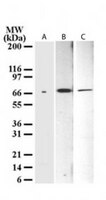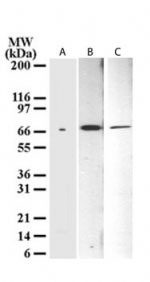OP181 Sigma-AldrichAnti-ΔNp73 Mouse mAb (38C674)
This Anti-ΔNp73 Mouse mAb (38C674) is validated for use in Immunoblotting for the detection of ΔNp73.
More>> This Anti-ΔNp73 Mouse mAb (38C674) is validated for use in Immunoblotting for the detection of ΔNp73. Less<<Productos recomendados
Descripción
| Replacement Information |
|---|
Tabla espec. clave
| Species Reactivity | Host | Antibody Type |
|---|---|---|
| H | M | Monoclonal Antibody |
Precios y disponibilidad
| Número de referencia | Disponiblidad | Embalaje | Cant./Env. | Precio | Cantidad | |
|---|---|---|---|---|---|---|
| OP181-100UG |
|
Ampolla de plást. | 100 μg |
|
— |
| References | |
|---|---|
| References | Levrero, M., et al. 2000 J. Cell Sci. 113, 1661. Yang, A., et al. 2000. Nature 404, 99. Ueda, Y., et al. 1999. Oncogene 18, 4993. Kaghad, M., et al. 1997. Cell 90, 809. |
| Product Information | |
|---|---|
| Form | Liquid |
| Formulation | In PBS, 0.2% gelatin. |
| Positive control | Cell lines transfected with ΔNp73 |
| Preservative | ≤0.1% sodium azide |
| Quality Segment | MQ100 |
| Physicochemical Information |
|---|
| Dimensions |
|---|
| Materials Information |
|---|
| Toxicological Information |
|---|
| Safety Information according to GHS |
|---|
| Safety Information |
|---|
| Product Usage Statements |
|---|
| Packaging Information |
|---|
| Transport Information |
|---|
| Supplemental Information |
|---|
| Specifications |
|---|
| Global Trade ITEM Number | |
|---|---|
| Número de referencia | GTIN |
| OP181-100UG | 04055977208856 |
Documentation
Anti-ΔNp73 Mouse mAb (38C674) Ficha datos de seguridad (MSDS)
| Título |
|---|
Anti-ΔNp73 Mouse mAb (38C674) Certificados de análisis
| Cargo | Número de lote |
|---|---|
| OP181 |
Referencias bibliográficas
| Visión general referencias |
|---|
| Levrero, M., et al. 2000 J. Cell Sci. 113, 1661. Yang, A., et al. 2000. Nature 404, 99. Ueda, Y., et al. 1999. Oncogene 18, 4993. Kaghad, M., et al. 1997. Cell 90, 809. |
Citas
| Título | |
|---|---|
|
|
| Ficha técnica | ||||||||||||||||||||||||||||||||||||||||||||||
|---|---|---|---|---|---|---|---|---|---|---|---|---|---|---|---|---|---|---|---|---|---|---|---|---|---|---|---|---|---|---|---|---|---|---|---|---|---|---|---|---|---|---|---|---|---|---|
|
Note that this data sheet is not lot-specific and is representative of the current specifications for this product. Please consult the vial label and the certificate of analysis for information on specific lots. Also note that shipping conditions may differ from storage conditions.
|








